Sea Kayaking to the Top of Europe
A Plan
I love longer sea kayaking trips. It takes me a few days to switch off from the real world and get into the ebb and flow of an expedition. It’s usually not until day three that all of my bits of kit have found their homes within the boat.
Expedition life is simple; eat, sleep, paddle, repeat (ideally interspersed with a few extra eats)! Life has enough challenge to keep you interested, but if you do it right, life is comfortable enough.
On this trip, Jen (my partner in paddling and in life) and I were lucky enough to have five weeks to journey around Northern Norway. After some deliberation we decided to set off from Tromsø with a plan to paddle around North Cape, stopping when we ran out of time or (ideally shortly before) people started speaking Russian.
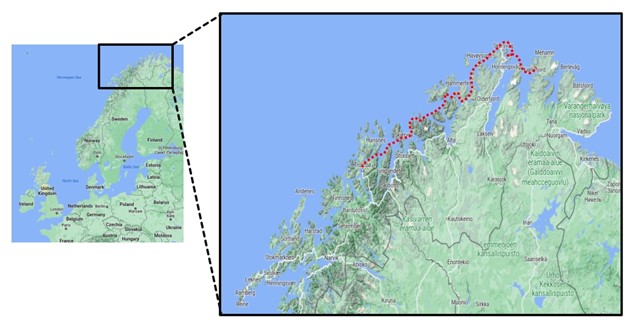
History
Seafaring has always been a big part of life in Northern Norway, with petroglyphs featuring boats dating back 7000, possibly as many as 10,000 years. We encountered wrecks all around the coast, with abandoned wooden boats rotting away above the high tide mark, hauled out for one last winter but never relaunched in the spring.
Both the Sami and Vikings were famous for their boating prowess, but as far as I can discover these were generally open boats which were rowed or sailed.
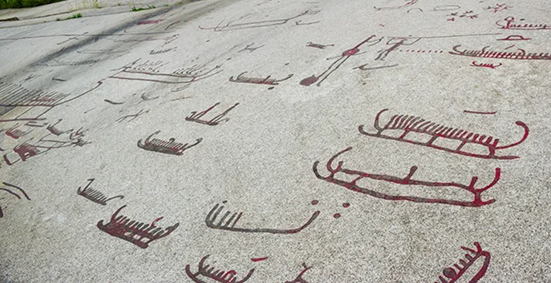
Skipping forwards, July 1975 saw the British Kayak Expedition to Nordkapp reach their destination, having set off from Bodo in their brand-new Valley Nordkapp kayaks which were designed specially for the trip. Their expedition report is available online and is well worth a read.
More recently, in 2009 James Baxter completed a remarkable 6000km journey, skiing up the whole length of Norway before sea kayaking back again.
Getting Organised
Much credit to Jenny who did most of the hard work finding and printing maps and charts. We both did our tidal planning independently, scouring the Admiralty and Imray pilot books, finding plenty of references to strong or very strong tidal flow (and even the occasional ‘tremendous’!), but fewer useful speeds or timings than you’d find in around the UK. We only got round to comparing our tidal information out on the water, where (to my relief) we’d mostly come up with the same numbers.
Previous trips to Norway had shown us that our stumbling attempts to speak Norwegian usually prompted a reply in excellent English. This time we both attempted to improve our Norwegian with an online course, although we were sceptical how useful phrases such as “Klovnen har ni lilla ballonger” (the clown has nine purple balloons) would prove to be on our trip.
A busy summer paddling season rushed by, and all of a sudden we were throwing kit in the back of my tatty old car and driving down to Hull to catch the overnight ferry. Another two and a half days of driving saw us arrive just north of Tromsø to answer the eternal sea kayaking question: “How the heck is all this stuff going to fit into those wee boats?”. Despite the heaviest rain of the whole trip, we eventually completed our game of sea kayak Tetris and paddled off into a calm, grey evening.
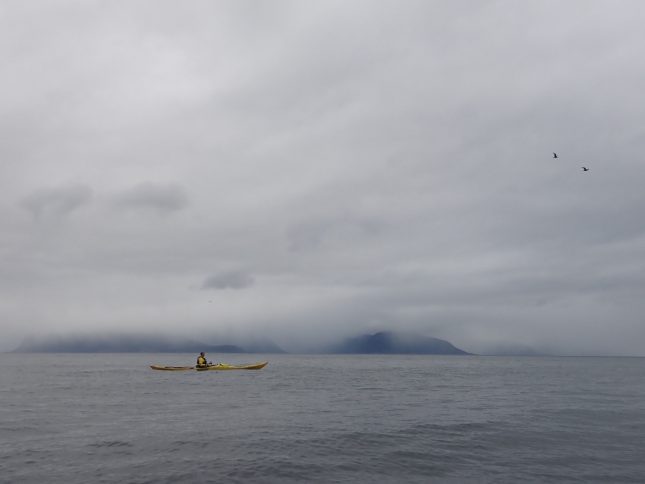
Week 1
The first few days were grey, damp and dreich. Apparently we paddled past some beautiful mountains in the Lyngen Alps, but with the cloud base down around 200 feet we didn’t see much of them. What we did see were White-tailed Eagles; more than ten on several days. A small but well loved bothy at Lyngstuva on the very northern tip of the Lyngen peninsula provided a sheltered spot for porridge. On day 6, after an early start and a breezy open crossing, the sun finally emerged and we decided to take a day off. In more than 20 years of paddling together I think this was the first time we’ve decided to take a day off on a paddleable day, and it was a delight. The sun shone as we pitched the tent on lovely springy tundra, overflowing with blaeberries and crowberries. The cracks between the rock ledges sheltered a friendly mouse, which I introduced to cheese.
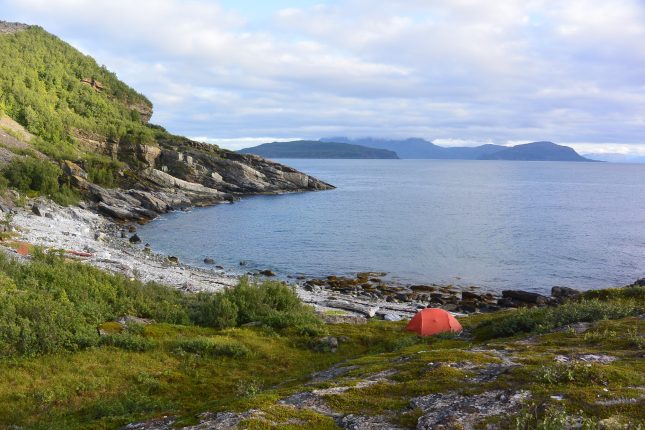
Week 2
This week saw great weather and a sequence of stunning camping spots. An inconsistent but deteriorating weather forecast led to us dithering about which route to take (in the end we erred on the side of caution and took the long but sheltered route). We encountered a rather sinister looking group of Reindeer, who had recently shed their velvet, leaving them with blood red antlers. The males shed their antlers at the end of the rut, whilst the females retain theirs over winter (so I think Rudolph is a girl).
We dropped back to the mainland to resupply at Kvalsund. I’ve always thought of Norway as an expensive country, but the food prices were about the same as in my local shop in the Cairngorms. I’d love to say that’s because prices in Norway have dropped, but it’s not. We sat on the slipway boiling eggs and eating pastries.
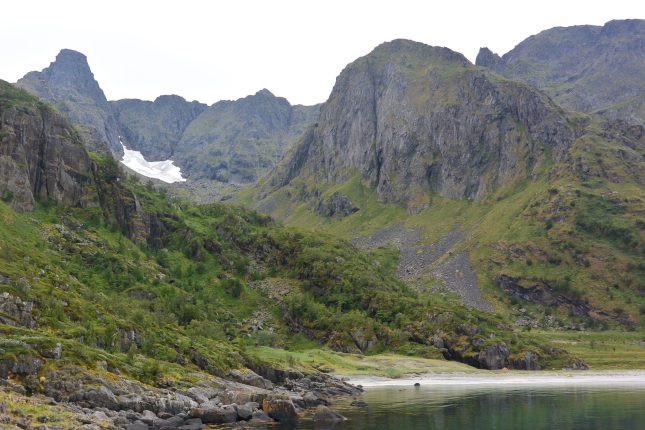
Week 3
On week 3 the landscape started to change. There were fewer islands to hide behind and more time spent crossing the open sea over to the next headland. A friendly whale (I’ll assume a Minke until someone tells me otherwise) came to check us out as we crossed over to Masoy. A pair of Arctic Terns decided to see us noisily off their territory, bombing around us in spite of being a good mile offshore of their colony.
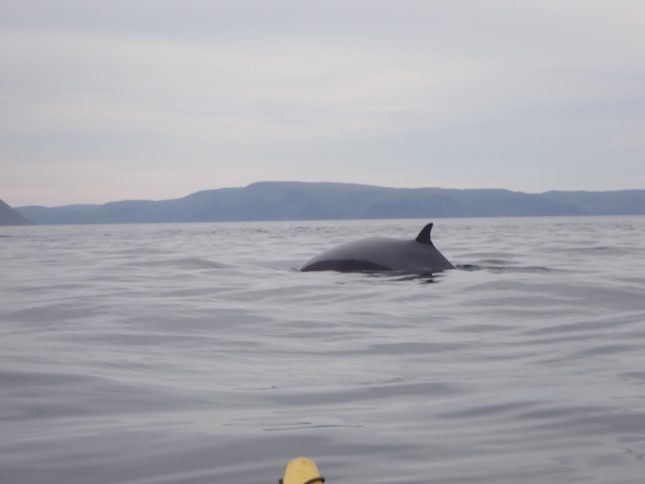
Towards the end of the week the weather started to look more ominous, with strong south westerlies forecast. Fortunately, we had one more stunning calm day to get past the beautiful Gjesværstappan islands, and on around the North Cape. As with Land’s End and Lizard, the actual most northerly point of Europe (excluding Svalbard for the pedants) is an understated headland which rejoices in the name of Knivskjellodden (for which my very amateur translation would be the knife shell promontory). It looks across to the far more dramatic 1000 foot cliffs of Nordkapp.
A long day took us to the Nordkapp Campsite near Honningsvag, who took great care of us. The heavy rain and flapping tent the following day told us that the storm had arrived, that it was time for another day off; also time for my first hot shower in 19 days.
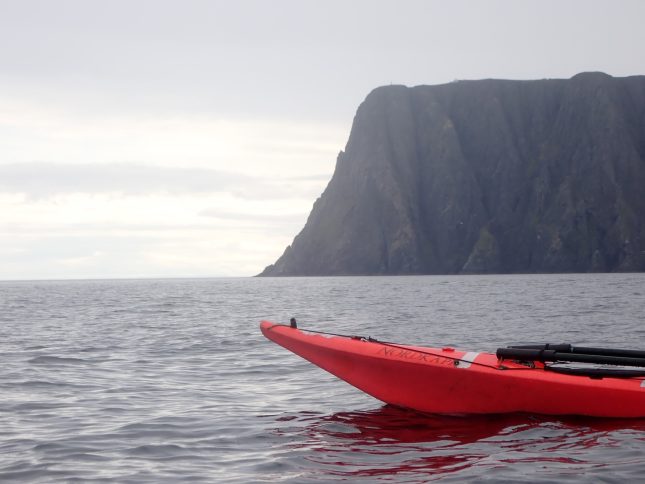
Week 4
The weather forecast showed a couple of days lull before the next low pressure system arrived, but the sea was still carrying a decent swell from the recent storm. We launched in a sheltered bay, but as we pressed on past the isolated lighthouse at Helnes Fyr it wasn’t looking like a great idea to attempt the 15km crossing over to the remote Svaerholt peninsula. We retreated to a lovely, abandoned harbour just a couple of miles from the lighthouse. The wharf and slipway were built from thousands of stone blocks, the biggest of which must have weighted several tonnes. A humongous amount of labour must have gone into building what now stands deserted, slowly being picked away by storms crashing in from the Arctic. As Shelley said, “Look on my works, ye Mighty, and despair!”
For two soggy sea kayakers it provided a welcome respite. A well weathered whale vertebra on the beach, maybe 35cm in diameter gave a clue to the history of the place.
The sea had dropped the following day and the forecast still gave us a 36 hour weather window. A fishing boat came over to check us out on the crossing over to Svaerholt. No words, but a friendly nod. With about 3km to go, I presumptuously said “we should be there in half an hour”. Cue a force 6-7 headwind, as we both dug in and crept up to the bay, paddle stroke by paddle stroke.
That evening our weather window was definitely closing on us. We potentially had seven more paddling days, but the forecast looked as though we’d end up sitting out at least the first three or four, waiting for the next storm to pass. We made the painful but most likely correct decision to finish the trip at the end of the following day and booked a ticket on the Hurtigruten coastal boat to take us back to Tromso.
Awaking early, we saw not very much; a gloomy brume hung over the sea. With the conditions workable, the wind forecast to pick up and a ferry already booked we decided to paddle off for our final open crossing. With compass bearings set, GPS switched off but readily to hand if needed, we headed away from comfort of the land.
Two and a bit hours later, the cliffs appeared out of the grey murk at about the time we expected, with us in about the place we’d aimed to be. It shouldn’t surprise me, but I’m always pleasantly relieved when dead reckoning actually works!
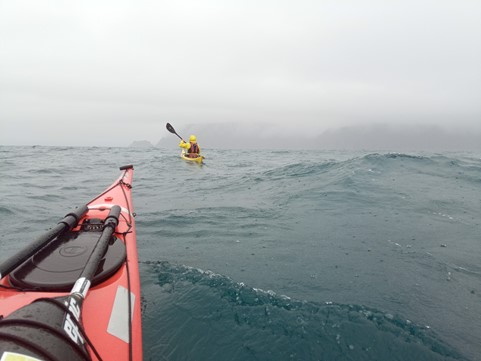
In the far north of Norway, greys and blacks replace greens as the predominant colours. The fractured cliffs at the mouth of the Kjollefjord made us feel as though we were paddling into Mordor. The cloud lifted as we dropped into the lee of the mountains. The town of Kjollefjord provided coffee, fresh orange juice and a brief sleep in a bed, before getting up to meet the ferry at 3am.
The terminal came to life about 10 minutes before the ferry arrived. After docking a large hatch opened up in the side of the ship and we carried our laden sea kayaks on board. The “MS Richard With” is one of the fourteen ships that ply the Hurtigrut (literally the fast route) along the length of the Norwegian coast. 130 years ago, this was the post boat and a vital supply line to remote towns and villages. Nowadays it’s mostly a cruise ship but they still take point to point passengers. When we weren’t gorging on the buffet, we sat in the jacuzzi at the stern of the ship, watching our previous month of campsites go by at a rate of about one per hour. If only every shuttle was as luxurious!
Reflections
Most of our longer sea kayaking trips feature some level of mild misadventure; a point at which things nearly unravel. On this trip everything went weirdly to plan. We didn’t experience any gnarly conditions and the month was none the worse for that.
I’m slightly disappointed that we didn’t complete the last 200 km to the border. I’d love to go back, but it’s a long way to travel and an awful lot of environmental impact for what would be quite a short paddle.
Lots of paddling and mountaineering literature uses the external journey as a metaphor for the internal journey. Perhaps I’m old enough and too fixed in my ways to feel especially changed by this trip; but it’s still a great privilege to be able to take a decent chunk of time out of day to day living and spend it with someone I love, plodding our way slowly through a beautiful wild landscape.
Maybe it’s not about the destination, it’s not about the bragging rights: it’s about the journey. Perhaps the same is true of life.
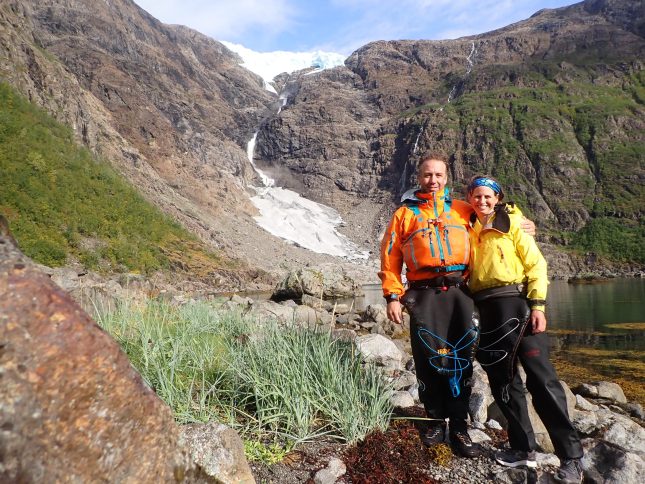
If you’re planning to head to northern Norway and want to chat about logistics, feel free to get in touch! Email: [email protected]
Finally, thanks very much to PeakPS for all the shiny kit.
The Adventure Double jacket kept me dry even when it drizzled for a week. And the brand-new pair of Explorer Salopettes meant that I still had dry (if exceptionally malodourous) socks at the end.
Sea Kayaking With Glenmore Lodge
Inspired to seek out a sea kayaking adventure? Check out our selection of sea kayaking courses for all experience levels:
Discover Sea Kayaking – perfect for those who are new and want to try out sea kayaking for the first time
Introduction to Sea Kayaking – a 5-day course that’ll cover learning to paddle a sea kayak and planning your own adventures, plus you’ll experience a 2-day trip with a night of camping
We also offer some truly spectacular 5-day guided sea kayak expeditions. Explore Scotland’s stunning coastline and islands with the support of one of our experienced staff. Find out more and join us this summer!